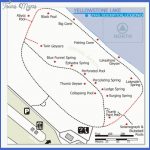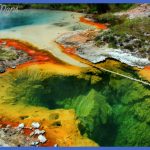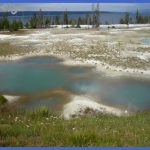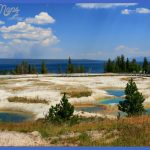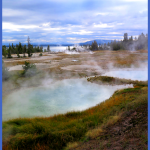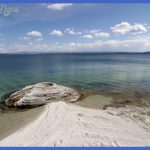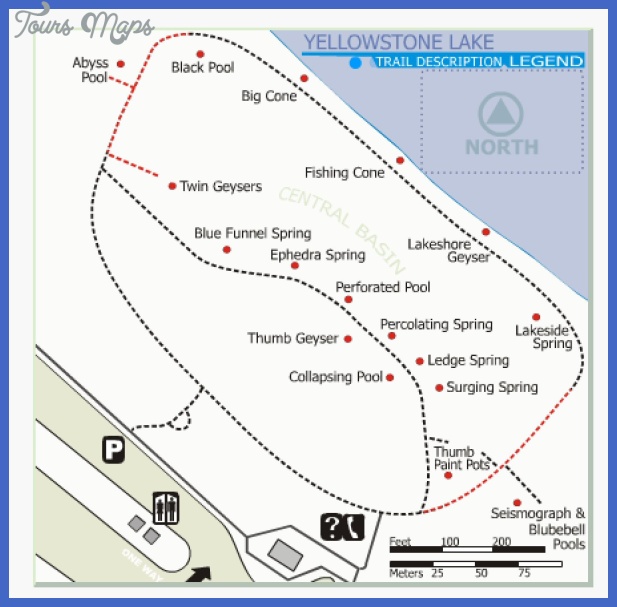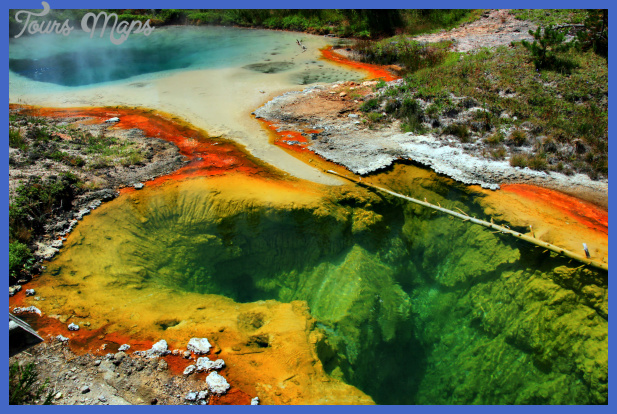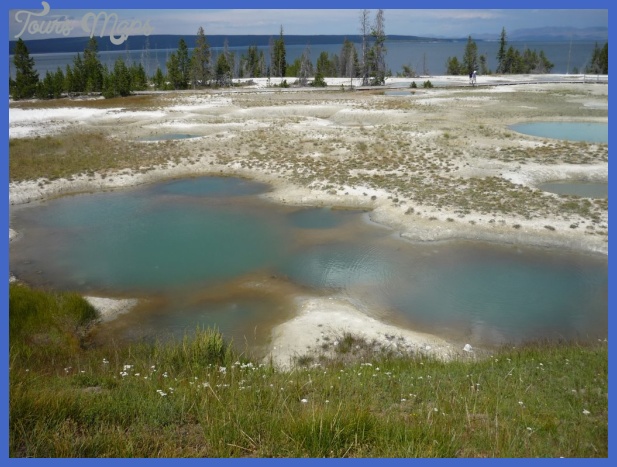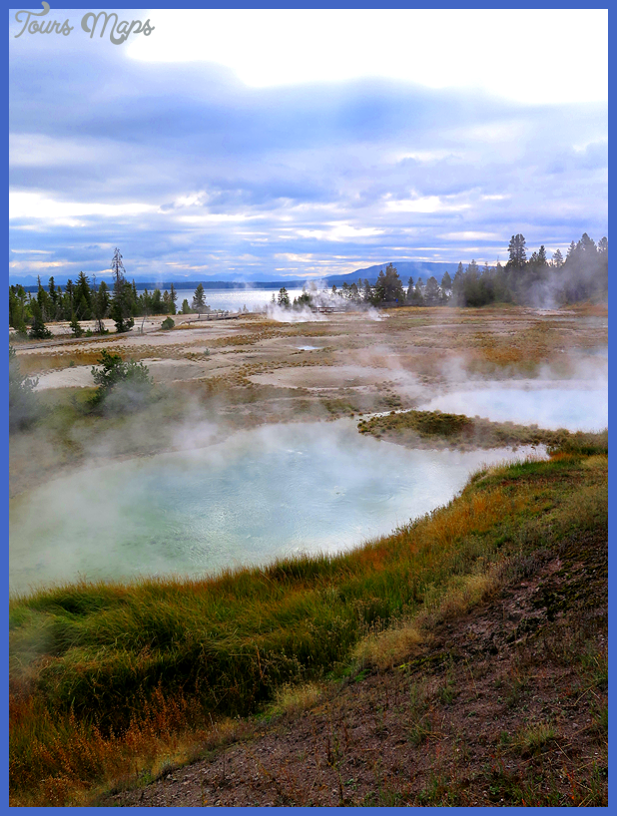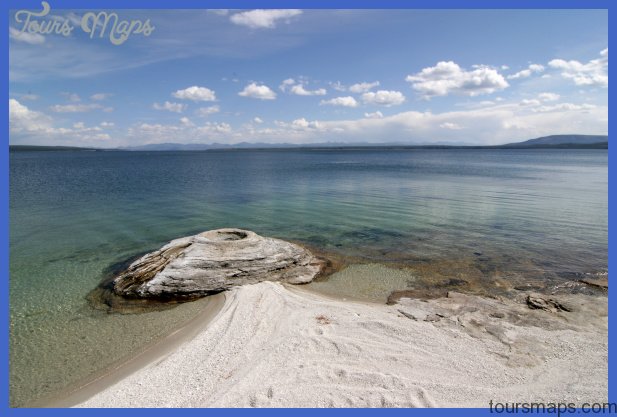Walking toward the lake from the parking lot, stay to the right to find the Thumb Paint Pots [GEO.21]. The paint pots were named Mud Puffs originally and perhaps more appropriately. The mud is formed by the action of sulfuric acid in the water on the rock it passes through. Historically, the pastel colors here were reported to be remarkable. Now they are duller at best and, depending on recent rainfall, vary from appearing like a muddy pond to just a dry area with a few mounds. Seismograph and Bluebell pools, on a spur to the right, differ from each other in temperature and sometimes in coloring. There may be extremely thick, colorful mats of bacteria and algae in the pools’ runoff. (These mats are explained in What Makes the Colors? on 65.) At the lakeshore are Lakeside Spring and Venting Pool, unremarkable features when they’re cool. However, when Lake- side Spring’s water is hot, its microorganisms are beautifully colored.
Look down from the boardwalk to see a remnant of the concrete that supported a boat dock here a century ago. A sign explains the West Thumb caldera. When the lake’s water level is high, the next features are entirely or almost submerged. Lakeshore Geyser has a sizeable cone, indicating considerable activity and a lower water level in the past geologists tell us sinter cones like these usually aren’t built under water. A pool to the left of the boardwalk shows what happens when thoughtless visitors throw things into hot springs, filling the vents and causing the water to cool. Ugly brown microorganism mats cover the bottom or float to the top. Fishing Cone is the most famous feature at West Thumb. It was where unfortunate trout find catching and cooking painfully near together, as his- Fishing Cone in the late 1800s, by W. H. Jackson. torian Chittenden wrote in 1895. In other words, early day tourists could catch a fish here and cook it without removing it from the hook. Regulations now prohibit fishing at or near West Thumb, since at least five people have perished over the years after falling into these hot springs. Two more cones (Big Cone and Little Cone) complete features at the lakeshore before the path leaves the lake. Inactive Little Cone is above the boardwalk, well away from the water.
You’ll next encounter Black Pool at the left and Abyss Pool a bit farther on at the right. Perhaps 50 yards (or meters) from the boardwalk next to Black Pool is King Geyser, whose eruptions are extremely rare but discharge an impressive amount of water when they occur. In 1991, Black Pool became much hotter than before and erupted for a brief period. This activity killed the bacterial mats, whose oranges and browns had combined with the usual blue of the water to give the pool an almost black color. Now Black Pool is often a lovely blue or green and is gradually cooling. West Thumb is anything but a static place! Proof of this is given by the recent history of Abyss Pool. A very explosive geyser in the early years of the 20 th century, Abyss then became dormant for something like 80 years. Then in 1991 and 1992, it erupted numerous times up to 100 feet (30 m) high, causing some of the nearby pools to drain. Since then, Abyss has quieted, but no one can guess how long it may remain that way. At 53 feet (16 m) deep, it’s one of the park’s deepest pools. It’s sometimes dicult to see the bottom through the lightly bubbling blue-green water. As you ascend the boardwalk’s hilly stretch, you can see that trees to your left have been killed by mineral-laden water. In this area, Hillside Geyser was erupt- Black Pool turned blue in 1991. To the west of the boardwalk intersection beyond the Twin Geysers overlook, an unnamed steam vent often makes a furious racket.
Just above here, road builders many years ago diverted the steam of a fumarole away from the construction site by cramming a pipe into it. The pipe ends here. The higher section of boardwalk (the former Grand Loop Road) returns you to the parking lot, past large hot pools called the Painted Pools or Mimulus Pools, after the Latin name for monkey-flowers. To see several other geysers and hot springs, follow the lower boardwalk to the left. This part of the geyser basin is especially prone to energy surges, that is, brief periods when hot springs become geysers and known geysers increase their frequency and size. It’s hard to believe that the now relatively calm springs called Twin Geysers could ever have been the largest geysers at West Thumb and a spectacular attraction, but in some decades of the 20th century, this was the case. Rising temperature and boiling activity in 1998 preceded renewed eruptions that August and occasional eruptions since. The temperature in one of the pools has sometimes measured 203°F (95°C) above the boiling point of water at this elevation.
The next notable feature is Blue Funnel Pool, an almost perfectly circular pool whose shape somewhat resembles Morning Glory Pool in Upper Geyser Basin. Ephydra Spring was named in the 1960s for the brine fly (Ephydra bruesi) that is common in alkaline thermal areas and feeds on microbes growing in the hot water. Several springs lie in an almost straight line; apparently they have developed along a slightly curving fracture under the earth. These springs include Blue Funnel, Ephydra, Perforated Pool, an unnamed pool with a black lining, Percolating Spring, Ledge Spring, and Surging Spring. Some of these springs have erupted as geysers, including Ledge Spring during the summer of 1999 and into this century. On the opposite side of the walkway is Thumb Geyser which has been known to erupt up to 25 feet (7.5 m) and also Collapsing Pool.
West Thumb Geyser Basin Photo Gallery
Maybe You Like Them Too
- The Best Cities To Visit in The World
- World’s 10 Best Places To Visit
- Coolest Countries in the World to Visit
- Travel to Santorini, Greece
- Map of Barbados – Holiday in Barbados

